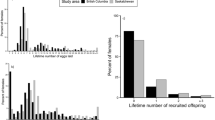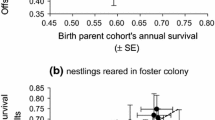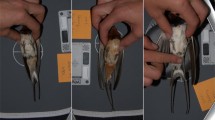Abstract
Temporally replicated studies are essential to describe and understand selection in natural populations. Selection patterns can differ among life stages representing different fitness components. Despite the increasing number of long-term studies, yearly estimates of fluctuation in strength and direction are mostly available from studies conducted on a limited number of years. Based on a population of Tree swallows (Tachycineta bicolor) monitored over 10,200 km2 in Southern Québec, Canada, since 2004, we investigated how patterns of selection may change across breeding stages by dividing the overall selection at the nesting stage (number of fledglings produced) into hatchling (number of hatchlings produced) and fledgling (number of hatchlings having successfully fledged) selection stages. We assessed fluctuation in selection gradients on two morphological (body mass and wing length) and two reproductive (laying date and clutch size) traits in females. We found significant positive selection gradients for body mass and clutch size and negative selection gradients for laying date, though the latter only during the fledgling selection stage. We also found that selection gradients on reproductive traits significantly fluctuated in direction and/or strength among years but only during the hatchling breeding stage. Our results thus emphasize the need to consider how selection events may be fluctuating in time and among breeding stages and the importance of these patterns for the maintenance of phenotypic variation in wild populations.


Similar content being viewed by others
References
Arnold, S. J., & Duvall, D. (1994). Animal mating systems: A synthesis based on selection theory. The American Naturalist, 143(2), 317–348. doi:10.2307/2462646.
Arnold, S. J., & Wade, M. J. (1984). On the measurement of natural and sexual selection: Applications. Evolution, 38(4), 720–734. doi:10.2307/2408384.
Bell, G. (2010). Fluctuating selection: The perpetual renewal of adaptation in variable environments. Philosophical Transactions of the Royal Society B: Biological Sciences, 365(1537), 87–97. doi:10.1098/rstb.2009.0150.
Both, C., Bouwhuis, S., Lessells, C. M., & Visser, M. E. (2006). Climate change and population declines in a long-distance migratory bird. Nature, 441(7089), 81–83. doi:10.1038/nature04539.
Bowlin, M. S., & Winkler, D. W. (2004). Natural variation in flight performance is related to timing of breeding in three swallows (Tachycineta bicolor) in New York. The Auk, 121(2), 345–353. doi:10.1642/0004-8038(2004)121[0345:nvifpi]2.0.co;2.
Carroll, S. P., Hendry, A. P., Reznick, D. N., & Fox, C. W. (2007). Evolution on ecological time-scales. Functional Ecology, 21(3), 387–393. doi:10.1111/j.1365-2435.2007.01289.x.
Charmantier, A., McCleery, R. H., Cole, L. R., Perrins, C., Kruuk, L. E. B., & Sheldon, B. C. (2008). Adaptive phenotypic plasticity in response to climate change in a wild bird population. Science, 320(5877), 800–803. doi:10.1126/science.1157174.
Chenoweth, S. F., & Blows, M. W. (2005). Contrasting mutual sexual selection on homologous signal traits in Drosophila serrata. The American Naturalist, 165(2), 281–289. doi:10.1086/427271.
Darimont, C. T., Carlson, S. M., Kinnison, M. T., Paquet, P. C., Reimchen, T. E., & Wilmers, C. C. (2009). Human predators outpace other agents of trait change in the wild. Proceedings of the National Academy of Sciences, 106(3), 952–954. doi:10.1073/pnas.0809235106.
Dunn, P. O., Winkler, D. W., Whittingham, L. A., Hannon, S. J., & Robertson, R. J. (2011). A test of the mismatch hypothesis: How is timing of reproduction related to food abundance in an aerial insectivore? Ecology, 92(2), 450–461. doi:10.1890/10-0478.1.
Endler, J. A. (1986). Natural selection in the wild. Princeton: Princeton University Press.
Garant, D., Hadfield, J. D., Kruuk, L. E. B., & Sheldon, B. C. (2008). Stability of genetic variance and covariance for reproductive characters in the face of climate change in a wild bird population. Molecular Ecology, 17(1), 179–188. doi:10.1111/j.1365-294X.2007.03436.x.
Garant, D., Kruuk, L. E. B., McCleery, R. H., & Sheldon, B. C. (2007). The effects of environmental heterogeneity on multivariate selection on reproductive traits in female great tits. Evolution, 61(7), 1546–1559. doi:10.1111/j.1558-5646.2007.00128.x.
Ghalambor, C. K., McKay, J. K., Carroll, S. P., & Reznick, D. N. (2007). Adaptive versus non-adaptive phenotypic plasticity and the potential for contemporary adaptation in new environments. Functional Ecology, 21(3), 394–407. doi:10.1111/j.1365-2435.2007.01283.x.
Ghilain, A., & Bélisle, M. (2008). Breeding success of tree swallows along a gradient of agricultural intensification. Ecological Applications, 18(5), 1140–1154. doi:10.1890/07-1107.1.
Gienapp, P., Teplitsky, C., Alho, J. S., Mills, J. A., & Merilä, J. (2008). Climate change and evolution: Disentangling environmental and genetic responses. Molecular Ecology, 17(1), 167–178. doi:10.1111/j.1365-294X.2007.03413.x.
Grant, P. R., & Grant, B. R. (2002). Unpredictable evolution in a 30-year study of Darwin’s finches. Science, 296(5568), 707–711.
Heaney, V., & Monaghan, P. (1996). Optimal allocation of effort between reproductive phases: The trade-off between incubation costs and subsequent brood rearing capacity. Proceedings of the Royal Society of London. Series B: Biological Sciences, 263(1377), 1719–1724. doi:10.1098/rspb.1996.0251.
Hendry, A. P., Farrugia, T. J., & Kinnison, M. T. (2008). Human influences on rates of phenotypic change in wild animal populations. Molecular Ecology, 17(1), 20–29. doi:10.1111/j.1365-294X.2007.03428.x.
Husby, A., Hille, S. M., & Visser, M. E. (2011a). Testing mechanisms of Bergmann’s rule: Phenotypic decline but no genetic change in body size in three passerine bird populations. The American Naturalist, 178(2), 202–213. doi:10.1086/660834.
Husby, A., Visser, M. E., & Kruuk, L. E. B. (2011b). Speeding up microevolution: The effects of increasing temperature on selection and genetic variance in a wild bird population. PLoS Biology, 9(2), e1000585. doi:10.1371/journal.pbio.1000585.
Kawecki, T. J., & Ebert, D. (2004). Conceptual issues in local adaptation. Ecology Letters, 7(12), 1225–1241.
Kingsolver, J. G., Diamond, S. E., Siepielski, A. M., & Carlson, S. M. (2012). Synthetic analyses of phenotypic selection in natural populations: Lessons, limitations and future directions. Evolutionary Ecology, 26(5), 1101–1118. doi:10.1007/s10682-012-9563-5.
Lande, R., & Arnold, S. J. (1983). The measurement of selection on correlated characters. Evolution, 37(6), 1210–1226. doi:10.2307/2408842.
Lane, J. E., Kruuk, L. E. B., Charmantier, A., Murie, J. O., & Dobson, F. S. (2012). Delayed phenology and reduced fitness associated with climate change in a wild hibernator. Nature, 489(7417), 554–557. doi:10.1038/nature11335.
Lebigre, C., Arcese, P., & Reid, J. M. (2013). Decomposing variation in male reproductive success: Age-specific variances and covariances through extra-pair and within-pair reproduction. Journal of Animal Ecology, 82(4), 872–883. doi:10.1111/1365-2656.12063.
Lessard, A., Bourret, A., Bélisle, M., Pelletier, F., & Garant, D. (2014). Individual and environmental determinants of reproductive success in male tree swallow (Tachycineta bicolor). Behavioral Ecology and Sociobiology, 68(5), 733–742. doi:10.1007/s00265-014-1686-y.
Martin, T. E., & Schwabl, H. (2008). Variation in maternal effects and embryonic development rates among passerine species. Philosophical Transactions of the Royal Society B: Biological Sciences, 363(1497), 1663–1674. doi:10.1098/rstb.2007.0009.
McGlothlin, J. W. (2010). Combining selective episodes to estimate lifetime nonlinear selection. Evolution, 64(5), 1377–1385. doi:10.2307/40663892.
Møller, A. P. (2013). Long-term trends in wind speed, insect abundance and ecology of an insectivorous bird. Ecosphere, 4(1), 6. doi:10.1890/es12-00310.1.
Møller, A. P., Chabi, Y., Cuervo, J. J., De Lope, F., Kilpimaa, J., Kose, M., et al. (2006). An analysis of continent-wide patterns of sexual selection in a passerine bird. Evolution, 60(4), 856–868. doi:10.1111/j.0014-3820.2006.tb01162.x.
Møller, A. P., & Szép, T. (2002). Survival rate of adult barn swallos Hirundo rustica in relation to sexual selection and reproduction. Ecology, 83(8), 2220–2228. doi:10.1890/0012-9658(2002)083[2220:sroabs]2.0.co;2.
Morrissey, M. B., & Hadfield, J. D. (2012). Directional selection in temporally replicated studies is remarkably consistent. Evolution, 66(2), 435–442. doi:10.1111/j.1558-5646.2011.01444.x.
Nooker, J. K., Dunn, P. O., Whittingham, L. A., & Murphy, M. T. (2005). Effects of food abundance, weather, and female condition on reproduction in tree swallows (Tachycineta bicolor). The Auk, 122(4), 1225–1238. doi:10.1642/0004-8038(2005)122[1225:eofawa]2.0.co;2.
Perrins, C. M. (1970). The timing of birds’ breeding seasons. Ibis, 112(2), 242–255. doi:10.1111/j.1474-919X.1970.tb00096.x.
Pischedda, A., & Rice, W. R. (2012). Partitioning sexual selection into its mating success and fertilization success components. Proceedings of the National Academy of Sciences, 109(6), 2049–2053. doi:10.1073/pnas.1110841109.
Porlier, M., Charmantier, A., Bourgault, P., Perret, P., Blondel, J., & Garant, D. (2012). Variation in phenotypic plasticity and selection patterns in blue tit breeding time: Between- and within-population comparisons. Journal of Animal Ecology, 81(5), 1041–1051. doi:10.1111/j.1365-2656.2012.01996.x.
Przybylo, R., Sheldon, B. C., & Merilä, J. (2000). Patterns of natural selection on morphology of male and female collared flycatchers (Ficedula albicollis). Biological Journal of the Linnean Society, 69(2), 213–232. doi:10.1111/j.1095-8312.2000.tb01199.x.
R Development Core Team. (2013). R: A language and environment for statistical computing. Vienna: Austria.
Reed, T. E., Jenouvrier, S., & Visser, M. E. (2013). Phenological mismatch strongly affects individual fitness but not population demography in a woodland passerine. Journal of Animal Ecology, 82(1), 131–144. doi:10.1111/j.1365-2656.2012.02020.x.
Reid, J. M., Monaghan, P., & Ruxton, G. D. (2000). Resource allocation between reproductive phases: The importance of thermal conditions in determining the cost of incubation. Proceedings of the Royal Society of London. Series B: Biological Sciences, 267(1438), 37–41. doi:10.1098/rspb.2000.0963.
Rioux Paquette, S., Garant, D., Pelletier, F., & Bélisle, M. (2013). Seasonal patterns in Tree Swallow prey (Diptera) abundance are affected by agricultural intensification. Ecological Applications, 23(1), 122–133. doi:10.1890/12-0068.1.
Rioux Paquette, S., Pelletier, F., Garant, D., & Bélisle, M. (2014). Severe recent decrease of adult body mass in a declining insectivorous bird population. Proceedings of the Royal Society B: Biological Sciences,. doi:10.1098/rspb.2014.0649.
Robillard, A., Garant, D., & Bélisle, M. (2013). The Swallow and the Sparrow: How agricultural intensification affects abundance, nest site selection and competitive interactions. Landscape Ecology, 28(2), 201–215. doi:10.1007/s10980-012-9828-y.
Schluter, D., Price, T. D., & Rowe, L. (1991). Conflicting selection pressures and life history trade-offs. Proceedings of the Royal Society of London. Series B: Biological Sciences, 246(1315), 11–17. doi:10.1098/rspb.1991.0118.
Sheldon, B. C., Kruuk, L. E. B., & Merilä, J. (2003). Natural selection and inheritance of breeding time and clutch size in the collared flycatcher. Evolution, 57(2), 406–420. doi:10.1111/j.0014-3820.2003.tb00274.x.
Shutler, D., Hussell, D. J. T., Norris, D. R., Winkler, D. W., Robertson, R. J., Bonier, F., et al. (2012). Spatiotemporal patterns in nest box occupancy by Tree swallows across North America. Avian Conservation and Ecology, 7(1), 3. doi:10.5751/ace-00517-070103.
Siepielski, A. M., DiBattista, J. D., & Carlson, S. M. (2009). It’s about time: The temporal dynamics of phenotypic selection in the wild. Ecology Letters, 12(11), 1261–1276.
Siepielski, A. M., DiBattista, J. D., Evans, J. A., & Carlson, S. M. (2011). Differences in the temporal dynamics of phenotypic selection among fitness components in the wild. Proceedings of the Royal Society B: Biological Sciences, 278(1711), 1572–1580. doi:10.1098/rspb.2010.1973.
Tarka, M., Akesson, M., Hasselquist, D., & Hansson, B. (2014). Intralocus sexual conflict over wing length in a wild migratory bird. The American Naturalist, 183(1), 62–73.
Tarwater, C. E., & Beissinger, S. R. (2013). Opposing selection and environmental variation modify optimal timing of breeding. Proceedings of the National Academy of Sciences, 110(38), 15365–15370. doi:10.1073/pnas.1303821110.
Teplitsky, C., Mouawad, N. G., Balbontin, J., De Lope, F., & Møller, A. P. (2011). Quantitative genetics of migration syndromes: A study of two barn swallow populations. Journal of Evolutionary Biology, 24(9), 2025–2039. doi:10.1111/j.1420-9101.2011.02342.x.
Teplitsky, C., Tarka, M., Møller, A. P., Nakagawa, S., Balbontín, J., Burke, T. A., et al. (2014). Assessing multivariate constraints to evolution across ten long-term avian studies. PLoS ONE, 9(3), e90444. doi:10.1371/journal.pone.0090444.
van de Pol, M., & Wright, J. (2009). A simple method for distinguishing within-versus between-subject effects using mixed models. Animal Behaviour, 77, 753–758.
van Tienderen, P. H. (2000). Elasticities and the link between demographic and evolutionary dynamics. Ecology, 81(3), 666–679. doi:10.1890/0012-9658(2000)081[0666:eatlbd]2.0.co;2.
Verhulst, S., & Nilsson, J.-Å. (2008). The timing of birds’ breeding seasons: A review of experiments that manipulated timing of breeding. Philosophical Transactions of the Royal Society B: Biological Sciences, 363(1490), 399–410. doi:10.1098/rstb.2007.2146.
Yeh, P. J., & Price, T. D. (2004). Adaptive phenotypic plasticity and the successful colonization of a novel environment. The American Naturalist, 164(4), 531–542. doi:10.1086/423825.
Acknowledgments
We would like to thank all the students and field assistants who helped gathering the data over the years, as well as the 40 farms owners for providing access to their land. We thank Cédric Frenette Dussault and three anonymous reviewers for comments on a previous draft version. This work was funded by grants from the Fonds de Recherche du Québec—Nature et Technologies (FRQNT) (D. G., F. P., M. B.), by Natural Sciences and Engineering Research Council of Canada (NSERC) Discovery grants (D. G., F. P., M. B.) and by the Canada Research Chairs program (F.P., M. B.).
Author information
Authors and Affiliations
Corresponding author
Electronic supplementary material
Below is the link to the electronic supplementary material.
Rights and permissions
About this article
Cite this article
Millet, A., Pelletier, F., Bélisle, M. et al. Patterns of Fluctuating Selection on Morphological and Reproductive Traits in Female Tree Swallow (Tachycineta bicolor). Evol Biol 42, 349–358 (2015). https://doi.org/10.1007/s11692-015-9333-8
Received:
Accepted:
Published:
Issue Date:
DOI: https://doi.org/10.1007/s11692-015-9333-8




